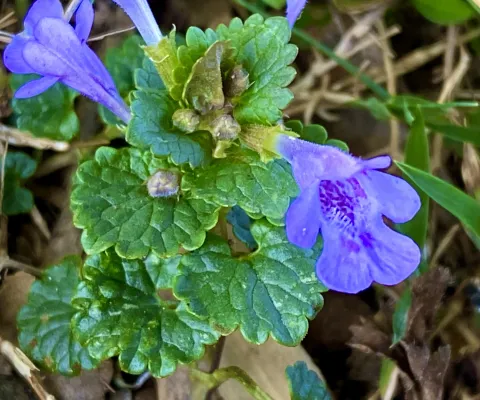Wildflower Watching

By Steve Roark
Volunteer, Cumberland Gap National Historical Park
Spring is a great time of year, when the dull brown of winter gives way to fresh grass, soft greens of newly opened leaves, and lots of flower blooms. Actively seeking out wildflowers in their varying habitats is an enjoyable way to spend warming spring days, roaming the woods and fields for some fresh air, exercise, and the challenge of the hunt. An additional challenge if you’re so inclined, is wildflower identification.
All it takes to enjoy this hobby is a good field guide of wildflowers, perhaps a notebook, and a camera if you’re so inclined. A car is handy for driving to parks and trailheads, but you don’t really need one, as there are plenty of wildflowers near you home. They can be found pretty much everywhere, in the woods, grass fields, your lawn, road banks, abandoned lots, cracks the sidewalk, almost any place with enough dirt for a seed to get a toe-hold.
Identifying a wildflower makes you really look at it closely: the leaves, petals, color, and shape, resulting in a better appreciation of their delicate beauty. Some are so small you may need a hand magnifier to see the details. There are many hundreds of wildflowers growing in our area, so don’t worry about running out of blooms to identify. I keep a life list of the ones I successfully identify, recording the name, location found, and date. I do this in the margins my identification guidebook, but you can keep a journal as well.
Most flowers that grow along roads and other disturbed areas are alien, coming from Europe and Asia long ago with our forefathers. The list of foreigners is long, including red clover, Queen Anne’s lace, spearmint, dandelion, chicory and many others.
If you would like to try your hand at wildflower ID, here are some good books to consider: A Field Guide to Wildflowers, by Roger Troy Peterson, is an easy-to-use picture guide that breaks down the different kinds of wildflowers first by color, then by general flower characteristics, and finally by well described field markings. Another user-friendly book is Wildflowers and Ferns of Kentucky, by Thomas Barnes and S. Wilson Francis. It breaks flowers out not only by color, but also season of bloom, which is really nice. Its use range includes all of our area. There are many other books out there, but be sure to flip through the book before you buy it to be sure the system of identification is comfortable for you.
Most wildflowers are seasonal and short lived, often growing, blooming, and fading away within a month’s time. So to catch the parade of flowers that flow through the year you need to get out there often to really enjoy the show.
- Log in to post comments